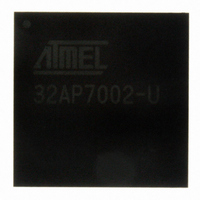AT32AP7002-CTUT Atmel, AT32AP7002-CTUT Datasheet - Page 292

AT32AP7002-CTUT
Manufacturer Part Number
AT32AP7002-CTUT
Description
IC MCU 32BIT AVR32 196-CBGA
Manufacturer
Atmel
Series
AVR®32 AP7r
Specifications of AT32AP7002-CTUT
Core Processor
AVR
Core Size
32-Bit
Speed
150MHz
Connectivity
EBI/EMI, I²C, MMC, PS2, SPI, SSC, UART/USART, USB
Peripherals
AC'97, DMA, I²C, LCD, POR, PWM, WDT
Number Of I /o
85
Program Memory Type
ROMless
Ram Size
32K x 8
Voltage - Supply (vcc/vdd)
1.65 V ~ 1.95 V
Data Converters
D/A 2x16b
Oscillator Type
Internal
Operating Temperature
-40°C ~ 85°C
Package / Case
196-CBGA
Data Bus Width
32 bit
Data Ram Size
32 KB
Interface Type
I2C, JTAG, PS2, SPI, SSC, UART, USART, USB
Maximum Clock Frequency
150 MHz
Number Of Timers
3
Maximum Operating Temperature
+ 85 C
Mounting Style
SMD/SMT
Minimum Operating Temperature
- 40 C
On-chip Dac
16 bit, 2 Channel
Package
196CTBGA
Device Core
AVR32
Family Name
AT32
Maximum Speed
150 MHz
Operating Supply Voltage
1.8|3.3 V
For Use With
ATAVRONEKIT - KIT AVR/AVR32 DEBUGGER/PROGRMMRATNGW100 - KIT AVR32 NETWORK GATEWAYATSTK1000 - KIT STARTER FOR AVR32AP7000
Lead Free Status / RoHS Status
Lead free / RoHS Compliant
Eeprom Size
-
Program Memory Size
-
Lead Free Status / Rohs Status
Details
Available stocks
Company
Part Number
Manufacturer
Quantity
Price
- Current page: 292 of 896
- Download datasheet (13Mb)
20.7.3
32054F–AVR32–09/09
Master Mode Operations
When configured in Master Mode, the SPI uses the internal programmable baud rate generator
as clock source. It fully controls the data transfers to and from the slave(s) connected to the SPI
bus. The SPI drives the chip select line to the slave and the serial clock signal (SPCK).
The SPI features two holding registers, the Transmit Data Register and the Receive Data Regis-
ter, and a single Shift Register. The holding registers maintain the data flow at a constant rate.
After enabling the SPI, a data transfer begins when the processor writes to the TDR (Transmit
Data Register). The written data is immediately transferred in the Shift Register and transfer on
the SPI bus starts. While the data in the Shift Register is shifted on the MOSI line, the MISO line
is sampled and shifted in the Shift Register. Transmission cannot occur without reception.
Before writing the TDR, the PCS field must be set in order to select a slave.
If new data is written in TDR during the transfer, it stays in it until the current transfer is com-
pleted. Then, the received data is transferred from the Shift Register to RDR, the data in TDR is
loaded in the Shift Register and a new transfer starts.
The transfer of a data written in TDR in the Shift Register is indicated by the TDRE bit (Transmit
Data Register Empty) in the Status Register (SR). When new data is written in TDR, this bit is
cleared. The TDRE bit is used to trigger the Transmit PDC channel.
The end of transfer is indicated by the TXEMPTY flag in the SR register. If a transfer delay (DLY-
BCT) is greater than 0 for the last transfer, TXEMPTY is set after the completion of said delay.
The master clock (MCK) can be switched off at this time.
The transfer of received data from the Shift Register in RDR is indicated by the RDRF bit
(Receive Data Register Full) in the Status Register (SR). When the received data is read, the
RDRF bit is cleared.
If the RDR (Receive Data Register) has not been read before new data is received, the Overrun
Error bit (OVRES) in SR is set. When this bit is set the SPI will continue to update RDR when
data is received, overwriting the previously received data. The user has to read the status regis-
ter to clear the OVRES bit.
Figure 20-5 on page 293
ure 20-6 on page 294
shows a flow chart describing how transfers are handled.
shows a block diagram of the SPI when operating in Master Mode.
AT32AP7002
Fig-
292
Related parts for AT32AP7002-CTUT
Image
Part Number
Description
Manufacturer
Datasheet
Request
R

Part Number:
Description:
DEV KIT FOR AVR/AVR32
Manufacturer:
Atmel
Datasheet:

Part Number:
Description:
INTERVAL AND WIPE/WASH WIPER CONTROL IC WITH DELAY
Manufacturer:
ATMEL Corporation
Datasheet:

Part Number:
Description:
Low-Voltage Voice-Switched IC for Hands-Free Operation
Manufacturer:
ATMEL Corporation
Datasheet:

Part Number:
Description:
MONOLITHIC INTEGRATED FEATUREPHONE CIRCUIT
Manufacturer:
ATMEL Corporation
Datasheet:

Part Number:
Description:
AM-FM Receiver IC U4255BM-M
Manufacturer:
ATMEL Corporation
Datasheet:

Part Number:
Description:
Monolithic Integrated Feature Phone Circuit
Manufacturer:
ATMEL Corporation
Datasheet:

Part Number:
Description:
Multistandard Video-IF and Quasi Parallel Sound Processing
Manufacturer:
ATMEL Corporation
Datasheet:

Part Number:
Description:
High-performance EE PLD
Manufacturer:
ATMEL Corporation
Datasheet:

Part Number:
Description:
8-bit Flash Microcontroller
Manufacturer:
ATMEL Corporation
Datasheet:

Part Number:
Description:
2-Wire Serial EEPROM
Manufacturer:
ATMEL Corporation
Datasheet:











